1,概述
前面我们说了volatile关键字,主要是为了处理并发读写场景,解决可见性的问题。然后又讲了synchronized锁,处理并发写的场景,解决原子性的问题。接着又说了Atomic原子系列,它是基于基本数据类型或者引用来解决原子问题,底层是基于CAS(compare and set),无锁化(乐观锁)。这篇文章主要来说说ReentractLock,先演示一个demo,对ReentractLock有个基本的了解。
public class ReentractLockDemo { #获取一个lock锁 static ReentrantLock lock = new ReentrantLock(); #可修改的共享变量 static volatile int flag = 0; public static void main(String[] args) { new Thread() { @Override public void run() { while (true) { //获取锁 lock.lock(); flag++; System.out.println(Thread.currentThread().getName() + "线程修改变后的变量为" + flag);
//释放锁 lock.unlock(); try { Thread.sleep(100); } catch (InterruptedException e) { e.printStackTrace(); } } } }.start(); new Thread() { @Override public void run() { while (true) {
//获取锁 lock.lock(); flag++; System.out.println(Thread.currentThread().getName() + "线程修改变后的变量为" + flag);
//释放锁 lock.unlock(); try { Thread.sleep(100); } catch (InterruptedException e) { e.printStackTrace(); } } } }.start(); } }
2,AQS(Abstract Queued Synchronizer)
2.1 简述
抽象队列同步器。经常听到这个词,本文就要分析下这到底是啥含义。并发包的锁都是基于AQS来实现的,一般我们开发是不直接接触的,它是并发的基础,java并发包底层的API。我们先画个图,了解下AQS的含义:
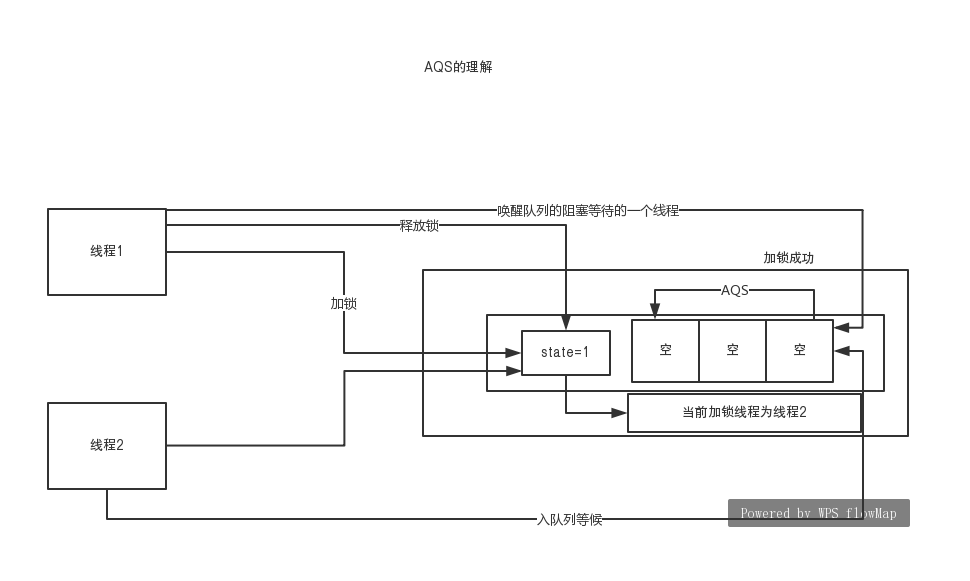
过程简述一下,当第一个线程获取锁时,将state状态+1,变成了1。此时当前加锁线程为线程1.然后线程2来获取锁,发现state不等于0,也就是有人占有了锁,此时线程2就到一个队列中排队。这时候线程3,线程N会依次来排队挂起。线程1处理任务完毕,将会唤醒队列中的线程,然后线程就去争取锁,获取到锁的线程就会出队列,重新改变state的值,将当前线程变为自己的。
大体过程如上所示,不过这样说起来还是太抽象了。我们从源码中去探索,看看是为啥叫AQS,队列是怎么实现的,怎么就实现了锁的功能了。。。
2.2 源码剖析
2.2.1首先看看ReentrantLock的构造函数。
public ReentrantLock() {
#当我们点进构造函数以后,发现里面构造了NonfairSync()对象。通过这里我们就能发现,ReentrantLock应该是一个外壳,真正执行功能的对象应该就是NonfairSync了。 sync = new NonfairSync(); }
#我们顺势就点开NonfairSync的构造函数了。发现它也是ReentrantLock的内部类,继承自Sync对象, static final class NonfairSync extends Sync { private static final long serialVersionUID = 7316153563782823691L; /** * Performs lock. Try immediate barge, backing up to normal * acquire on failure. */ final void lock() { if (compareAndSetState(0, 1)) setExclusiveOwnerThread(Thread.currentThread()); else acquire(1); } protected final boolean tryAcquire(int acquires) { return nonfairTryAcquire(acquires); } }
通过上面的源代码,就知道了ReentrantLock里面有内部类:NonfairSync、FairSync、Sync。NonfairSync、FairSync是Sync的子类,其中NonfailSync是默认构造函数实现的(也就是非公平锁,后面会讲解它和FairSync的区别)。而且ReentrantLock就是一个外壳,真正功能的实现就是Sync这些对象。我们再看看Sync这个类,发现他是一个抽象类,继承了AbstractQueuedSynchronizer这个类。源码如下:
abstract static class Sync extends AbstractQueuedSynchronizer
这时候发现AbstractQueuedSynchronizer。也就是我们之前说的AQS,抽象队列同步器。很明显了,核心的方法都应该在AbstractQueuedSynchronizer类里面了。来看看AbstractQueuedSynchronizer的核心的字段:
private transient Thread exclusiveOwnerThread;
#这是一个指针的头部
private transient volatile Node head; #指针的尾部 private transient volatile Node tail; #状态变量state private volatile int state; #这个应该似曾相识了,之前Atomic原子系列的CAS,就是基于unsafe来实现的。这里大概也能猜测到了,ReentractLock底层是基于CAS无锁化来实现的了 private static final Unsafe unsafe = Unsafe.getUnsafe();
#下面是一些变量的内存指针。 private static final long stateOffset; private static final long headOffset; private static final long tailOffset; private static final long waitStatusOffset; private static final long nextOffset;
看了上面的核心成员变量,大概能知道:之前所谓的队列应该就是一个双向链表实现的,获取到锁之后就更新state的状态。Node是AQS实现的一种数据结构,我们可以看看:
static final class Node { /** Marker to indicate a node is waiting in shared mode */ static final Node SHARED = new Node(); /** Marker to indicate a node is waiting in exclusive mode */ static final Node EXCLUSIVE = null; /** waitStatus value to indicate thread has cancelled */ static final int CANCELLED = 1; /** waitStatus value to indicate successor's thread needs unparking */ static final int SIGNAL = -1; /** waitStatus value to indicate thread is waiting on condition */ static final int CONDITION = -2; /** * waitStatus value to indicate the next acquireShared should * unconditionally propagate */ static final int PROPAGATE = -3; /** * Status field, taking on only the values: * SIGNAL: The successor of this node is (or will soon be) * blocked (via park), so the current node must * unpark its successor when it releases or * cancels. To avoid races, acquire methods must * first indicate they need a signal, * then retry the atomic acquire, and then, * on failure, block. * CANCELLED: This node is cancelled due to timeout or interrupt. * Nodes never leave this state. In particular, * a thread with cancelled node never again blocks. * CONDITION: This node is currently on a condition queue. * It will not be used as a sync queue node * until transferred, at which time the status * will be set to 0. (Use of this value here has * nothing to do with the other uses of the * field, but simplifies mechanics.) * PROPAGATE: A releaseShared should be propagated to other * nodes. This is set (for head node only) in * doReleaseShared to ensure propagation * continues, even if other operations have * since intervened. * 0: None of the above * * The values are arranged numerically to simplify use. * Non-negative values mean that a node doesn't need to * signal. So, most code doesn't need to check for particular * values, just for sign. * * The field is initialized to 0 for normal sync nodes, and * CONDITION for condition nodes. It is modified using CAS * (or when possible, unconditional volatile writes). */ volatile int waitStatus; /** * Link to predecessor node that current node/thread relies on * for checking waitStatus. Assigned during enqueuing, and nulled * out (for sake of GC) only upon dequeuing. Also, upon * cancellation of a predecessor, we short-circuit while * finding a non-cancelled one, which will always exist * because the head node is never cancelled: A node becomes * head only as a result of successful acquire. A * cancelled thread never succeeds in acquiring, and a thread only * cancels itself, not any other node. */ volatile Node prev; /** * Link to the successor node that the current node/thread * unparks upon release. Assigned during enqueuing, adjusted * when bypassing cancelled predecessors, and nulled out (for * sake of GC) when dequeued. The enq operation does not * assign next field of a predecessor until after attachment, * so seeing a null next field does not necessarily mean that * node is at end of queue. However, if a next field appears * to be null, we can scan prev's from the tail to * double-check. The next field of cancelled nodes is set to * point to the node itself instead of null, to make life * easier for isOnSyncQueue. */ volatile Node next; /** * The thread that enqueued this node. Initialized on * construction and nulled out after use. */ volatile Thread thread; /** * Link to next node waiting on condition, or the special * value SHARED. Because condition queues are accessed only * when holding in exclusive mode, we just need a simple * linked queue to hold nodes while they are waiting on * conditions. They are then transferred to the queue to * re-acquire. And because conditions can only be exclusive, * we save a field by using special value to indicate shared * mode. */ Node nextWaiter; /** * Returns true if node is waiting in shared mode. */ final boolean isShared() { return nextWaiter == SHARED; } /** * Returns previous node, or throws NullPointerException if null. * Use when predecessor cannot be null. The null check could * be elided, but is present to help the VM. * * @return the predecessor of this node */ final Node predecessor() throws NullPointerException { Node p = prev; if (p == null) throw new NullPointerException(); else return p; } Node() { // Used to establish initial head or SHARED marker } Node(Thread thread, Node mode) { // Used by addWaiter this.nextWaiter = mode; this.thread = thread; } Node(Thread thread, int waitStatus) { // Used by Condition this.waitStatus = waitStatus; this.thread = thread; } }
2.2.2 lock()方法。
//调用lock方法之后,底层调用的是Sync的lock方法
public void lock() { sync.lock(); } //发现Sync只是声明了这个方法,具体实现是子类来实现的 abstract void lock();
#这是默认的子类NonfairSync的lock()方法的实现。 final void lock() { if (compareAndSetState(0, 1)) setExclusiveOwnerThread(Thread.currentThread()); else acquire(1); }
compareAndSetState(0,1):
protected final boolean compareAndSetState(int expect, int update) { // See below for intrinsics setup to support this return unsafe.compareAndSwapInt(this, stateOffset, expect, update); }
这是采用了CAS操作来判断state字段,如果state=0,就设置为1:表示某个线程第一次获取锁,将state状态从0到1,并将当前占用线程设置为自己:
setExclusiveOwnerThread(Thread.currentThread())
否则,acquire(1):
public final void acquire(int arg) {
#在这里点进tryAcquire()方法,发现在AQS里面也是没有实现,所以查看了NonfairSync的tryAcquire()方法了。
if (!tryAcquire(arg) && acquireQueued(addWaiter(Node.EXCLUSIVE), arg)) selfInterrupt(); }
NonfairSync的tryAcquire()方法:
final boolean nonfairTryAcquire(int acquires) { final Thread current = Thread.currentThread();
#首先获取state的状态 int c = getState();
#如果等于0,说明没有线程获取到锁, if (c == 0) {
#此时该线程获取到锁,并将自己设为当前线程
if (compareAndSetState(0, acquires)) { setExclusiveOwnerThread(current); return true; } }
#否则说明有人占有锁,那么再判断下占有锁的线程是否是自己,是的话将state+1.这是什么意思呢??就是同一个线程可以获取到多次锁,也就是可重入锁。 else if (current == getExclusiveOwnerThread()) { int nextc = c + acquires; if (nextc < 0) // overflow throw new Error("Maximum lock count exceeded"); setState(nextc); return true; } return false; }
以上条件表示的就是获取锁成功的情况。如果获取锁失败会怎样??回到方法:
if (!tryAcquire(arg) && acquireQueued(addWaiter(Node.EXCLUSIVE), arg)) selfInterrupt(); }
如果获取锁失败,那么第一个条件就是true了。进入第二个条件:acquireQueued(addWaiter(Node.EXCLUSIVE), arg))
先看看addWaiter方法源码是怎么走的:
#该方法是构建一个node节点,然后调用enq方法
private Node addWaiter(Node mode) { Node node = new Node(Thread.currentThread(), mode); // Try the fast path of enq; backup to full enq on failure Node pred = tail; if (pred != null) { node.prev = pred; if (compareAndSetTail(pred, node)) { pred.next = node; return node; } } enq(node); return node; }
enq源码:
private Node enq(final Node node) { for (;;) { Node t = tail; if (t == null) { // Must initialize if (compareAndSetHead(new Node())) tail = head; } else { node.prev = t; if (compareAndSetTail(t, node)) { t.next = node; return t; } } } }
最后执行acquireQueued:
final boolean acquireQueued(final Node node, int arg) { boolean failed = true; try { boolean interrupted = false; for (;;) { final Node p = node.predecessor(); if (p == head && tryAcquire(arg)) { setHead(node); p.next = null; // help GC failed = false; return interrupted; } if (shouldParkAfterFailedAcquire(p, node) && parkAndCheckInterrupt()) interrupted = true; } } finally { if (failed) cancelAcquire(node); } }
上面几个方法其实就是基于链表来操作的,我觉得还是画个图来比较直观。
场景:首先是线程1来获取锁,获取成功,然后线程2,线程3来获取锁,获取失败,加入到队列的过程:
线程1获取锁成功:
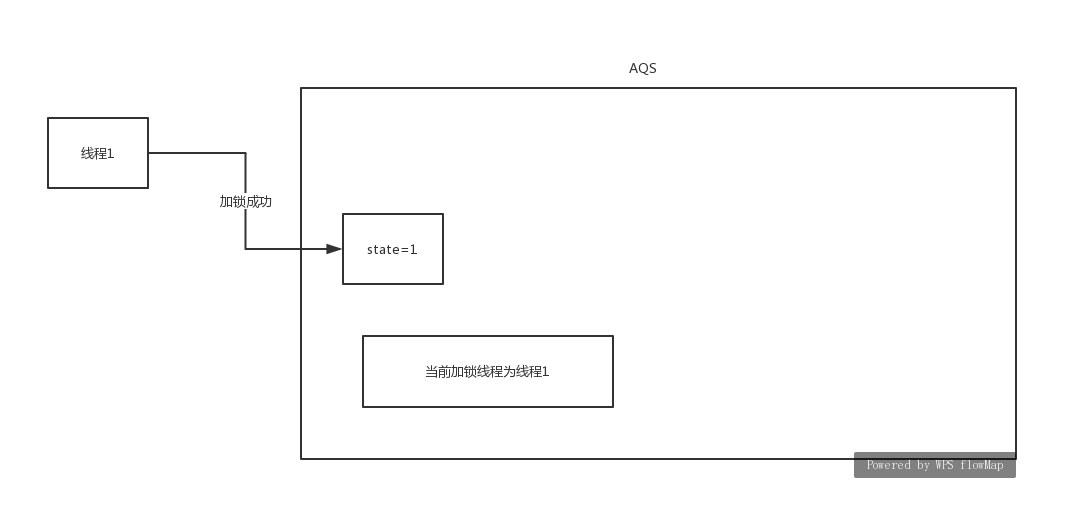
线程2获取锁失败,加入队列的过程:
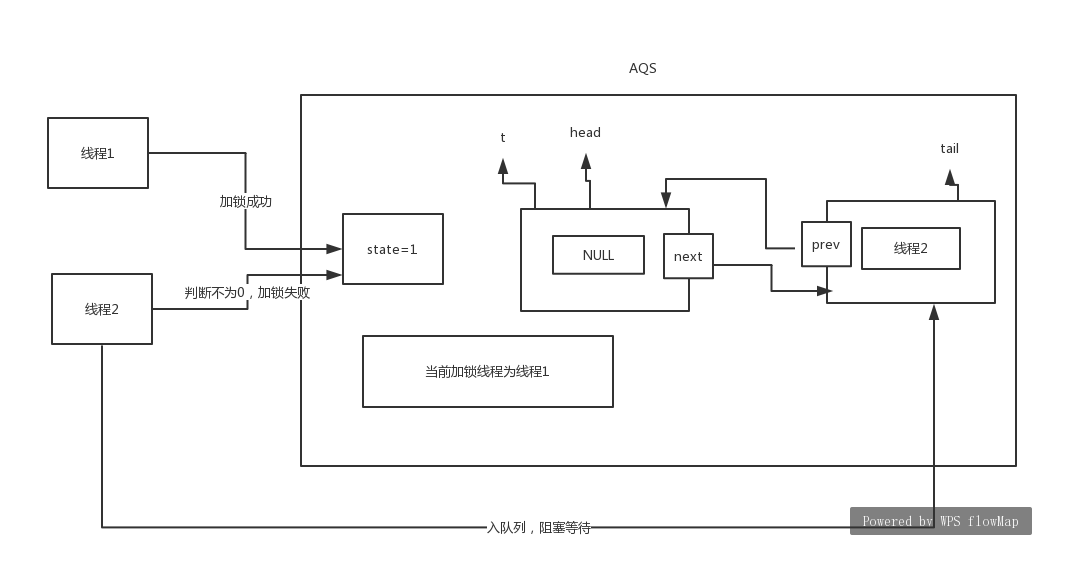
以上方法是加入到队列,至于线程挂起的源码如下:
final boolean acquireQueued(final Node node, int arg) { boolean failed = true; try { boolean interrupted = false; for (;;) { final Node p = node.predecessor(); if (p == head && tryAcquire(arg)) { setHead(node); p.next = null; // help GC failed = false; return interrupted; }
//此时线程2会走到这里. if (shouldParkAfterFailedAcquire(p, node) && parkAndCheckInterrupt()) interrupted = true; } } finally { if (failed) cancelAcquire(node); } }
里面让线程2挂起的源码:
private final boolean parkAndCheckInterrupt() { LockSupport.park(this); return Thread.interrupted(); }
线程3获取锁失败,加入队列:

通过上面基于源码来画图,就可以知道了。首先线程1,获取到了锁,其他线程就会形成一个双向链表,也就是所谓的队列操作,并且同步阻塞了。同时这里还有一点,就是在挂起之前,会再次尝试获取锁,这也就是为啥叫非公平锁了。比如线程3在挂起的时候就获取到了锁,那么提前等待的线程2,就明显不公平了。至于怎么唤醒这些队列的线程,后面再分析。这里还有个值得学习的地方LockSupport.park(this):表示对当前线程的挂起。
2.2.3 unlock()方法。
public void unlock() { sync.release(1); } public final boolean release(int arg) {
//AQS也是没有实现的,在ReentrantLock里面有具体的实现。 if (tryRelease(arg)) { Node h = head; if (h != null && h.waitStatus != 0) unparkSuccessor(h); return true; } return false; }
tryRelease的实现:
protected final boolean tryRelease(int releases) {
//首先将state的变量值-1 int c = getState() - releases;
//不是占有的线程去释放,就报异常 if (Thread.currentThread() != getExclusiveOwnerThread()) throw new IllegalMonitorStateException(); boolean free = false; if (c == 0) { free = true; setExclusiveOwnerThread(null); } setState(c); return free; }
上面这段代码的意思是,当线程执行unlock()方法之后,state就一直减1,直到0为止,然后将当前加锁线程设为NULL。从队列中唤醒的源码就是这一段了:
Node h = head; if (h != null && h.waitStatus != 0) unparkSuccessor(h); return true;
核心在unparkSuccessor()方法,我们去看一下:
private void unparkSuccessor(Node node) { int ws = node.waitStatus; if (ws < 0) compareAndSetWaitStatus(node, ws, 0); //按照上文的分析,这个s其实就是线程2 Node s = node.next; if (s == null || s.waitStatus > 0) { s = null; for (Node t = tail; t != null && t != node; t = t.prev) if (t.waitStatus <= 0) s = t; } if (s != null) LockSupport.unpark(s.thread); }
从这里可以看出来当线程1执行unpark()方法的时候,就会唤醒队列的头结点的next节点,也就是线程2所在的节点了。当线程2唤醒以后,就从上文挂起的地方活过来,又开始争抢锁的操作。回到源码这一段中:
final boolean acquireQueued(final Node node, int arg) { boolean failed = true; try { boolean interrupted = false; for (;;) { final Node p = node.predecessor(); if (p == head && tryAcquire(arg)) { setHead(node); p.next = null; // help GC failed = false; return interrupted; } if (shouldParkAfterFailedAcquire(p, node) && parkAndCheckInterrupt()) interrupted = true; } } finally { if (failed) cancelAcquire(node); } }
此时应该从挂起的地方苏醒过来,重新执行上文中的for循环了。然后线程2就会获取到锁,当前加锁的线程=线程2.然后将链表的head下移一位,链表的线程2设置为NULL。这样就相当于线程2从队列中弹出了。最后再来回顾一下前面的操作:lock()方法,就是获取锁的操作,当线程1来的时候,没有人持有锁,所以线程1获取锁成功,修改state状态,设置当前线程为线程1;这时候线程2,线程3依次过来那么线程2,线程3会形成一个双向链表(队列),并且会同步挂起。当线程1执行了unlock()方法,其实就是修改state状态,将当前线程置为NULL,然后最重要的一步是唤醒了队列头的线程。这就是为啥能满足先进先出的原因了。此时线程2被唤醒以后,修改state状态,将当前线程=线程2,然后将链表head的线程与整个链表断开,然后把链表中的线程2设置为NULL的Node。整个锁的操作设计的很巧妙,通过一个state状态来控制,非常值得大家学习这个过程。
3,公平锁和非公平锁
前面我们知道默认情况下是使用非公平锁来实现的,而且非公平锁的性能高。但是这是为什么呢?我们通过源码来剖析原因。
ReentractLock有两种构造函数
public ReentrantLock() { sync = new NonfairSync(); } /** * Creates an instance of {@code ReentrantLock} with the * given fairness policy. * * @param fair {@code true} if this lock should use a fair ordering policy */ public ReentrantLock(boolean fair) { sync = fair ? new FairSync() : new NonfairSync(); }
前面我们用的都是默认的构造函数。当传入参数true,则使用的是公平锁的方式了。同理我们也要再次看lock()方法和unlock()方法了。因为前面详细分析过,这部分我们主要查看有哪些不同。
FairSync方法实现的lock()方法中,
final void lock() { acquire(1); }
这和之前的非公平锁是不一样的,非公平锁的实现再贴一下:
final void lock() { if (compareAndSetState(0, 1)) setExclusiveOwnerThread(Thread.currentThread()); else acquire(1); }
区别是什么??非公平锁上来就是直接判断state是否等于0,等于0就尝试获取锁。意味着什么呢?意味着就算没有进入队列的线程,也可以直接参与争抢锁。类比很多人在排队买东西,有个人直接过来就买了,不排队了,,不公平!!
继续看下去,下面就是方法acquire():
public final void acquire(int arg) { if (!tryAcquire(arg) && acquireQueued(addWaiter(Node.EXCLUSIVE), arg)) selfInterrupt(); }
这个方法前面都分析过。这里我们唯一需要看的就是tryAcquire()方法,因为它是具体子类的实现,我们之前看的都是NonfairSync,这里应该看FairSync了:
protected final boolean tryAcquire(int acquires) { final Thread current = Thread.currentThread(); int c = getState(); if (c == 0) {
#如果state=0,也就是没有人占有锁的情况下,会先去查看线程是否在队列中,这样就能彻底实现公平了。 if (!hasQueuedPredecessors() && compareAndSetState(0, acquires)) { setExclusiveOwnerThread(current); return true; } } else if (current == getExclusiveOwnerThread()) { int nextc = c + acquires; if (nextc < 0) throw new Error("Maximum lock count exceeded"); setState(nextc); return true; } return false; }
这里也就发现了。公平锁和非公平锁的差别就是在争抢锁的时候是否会判断队列。公平锁会严格的去判断队列里是否含有该线程,所以会有遍历链表的操作,这也是为啥性能没有非公平锁高了。。但是公平锁严格遵循公平的原则了,所以使用哪一个就要根据场景了。一般情况下是使用非公平锁,提高性能。
4,读写锁
分析完了ReentrantLock以后,再来谈谈读写锁。它是将读写进行了分离,读线程可以同时多个并行,写请求只有一个线程,读写是互斥的。先写个demo,然后方便分析读写锁的源码:
public class ReentractReadWriteLockDemo { static ReentrantReadWriteLock lock = new ReentrantReadWriteLock(); //获取写锁 static ReentrantReadWriteLock.WriteLock writeLock = lock.writeLock(); //获取读锁 static ReentrantReadWriteLock.ReadLock readLock = lock.readLock(); public static void main(String[] args) { writeLock.lock(); writeLock.unlock(); readLock.lock(); readLock.unlock(); } }
首先看看ReentrantReadWriteLock的构造函数的内容:
public ReentrantReadWriteLock() { this(false); } public ReentrantReadWriteLock(boolean fair) {
//默认的是非公平锁 sync = fair ? new FairSync() : new NonfairSync(); readerLock = new ReadLock(this); writerLock = new WriteLock(this); }
//通过这里可以看出来,所谓的readLock或者是WriteLock底层的实现其实就是sync,ReentrantReadWriteLock就是一个包装的外壳。ReadLock和WriteLock都是ReentrantReadWriteLock都是其内部类。
protected ReadLock(ReentrantReadWriteLock lock) {
sync = lock.sync;
}
写锁的lock()方法剖析:
public void lock() { sync.acquire(1); } #这个方法是不是很熟悉。就是AQS类的方法,tryAcquire()方法在AQS没有实现,所以我们应该看看你它的具体实现。 public final void acquire(int arg) { if (!tryAcquire(arg) && acquireQueued(addWaiter(Node.EXCLUSIVE), arg)) selfInterrupt(); }
那么重点就是看砍tryAcquire()方法了,通过之前的分析已经很清楚了,这个方法其实就是加锁的操作,具体看看它的实现:
protected final boolean tryAcquire(int acquires) { Thread current = Thread.currentThread();
//获取state的值 int c = getState();
//这是重点:读写锁是巧妙的运用了state是int类型,32位,将前面的16位(高位)作为读锁,后面的16位(低位)作为写锁的标志。这就是获取低16位,写锁。 int w = exclusiveCount(c);
//说明是加锁了 if (c != 0) { // (Note: if c != 0 and w == 0 then shared count != 0)
//说明是加了读锁或者是加了写锁,但是 不是该线程。 if (w == 0 || current != getExclusiveOwnerThread()) return false; if (w + exclusiveCount(acquires) > MAX_COUNT) throw new Error("Maximum lock count exceeded"); // Reentrant acquire setState(c + acquires); return true; }
//前一个方法表示是公平锁实现还是非公平锁实现的,公平锁还要再判断是否在队列里,非公平锁则不需要。 if (writerShouldBlock() || !compareAndSetState(c, c + acquires)) return false; setExclusiveOwnerThread(current); return true; }
写锁的整个流程还是很清晰的,我们可以根据源码画图,场景:线程1第一次来获取锁,线程1重入加锁,线程2来获取锁,但是没有成功,入队列:

加读锁,源码如下:
public void lock() { sync.acquireShared(1); } public final void acquireShared(int arg) {
//可以发现AQS也没有实现tryAcquireShared()方法,那么看子类是如何实现的,也是重点剖析的 if (tryAcquireShared(arg) < 0) doAcquireShared(arg); }
tryAcquireShared()方法的具体实现:
protected final int tryAcquireShared(int unused) { Thread current = Thread.currentThread(); int c = getState();
//判断别的线程是否占有了写锁 if (exclusiveCount(c) != 0 && getExclusiveOwnerThread() != current) return -1;
//获取高16位,判断是否加了读锁 int r = sharedCount(c); if (!readerShouldBlock() && r < MAX_COUNT && compareAndSetState(c, c + SHARED_UNIT)) { if (r == 0) { firstReader = current; firstReaderHoldCount = 1; } else if (firstReader == current) { firstReaderHoldCount++; } else { HoldCounter rh = cachedHoldCounter; if (rh == null || rh.tid != getThreadId(current)) cachedHoldCounter = rh = readHolds.get(); else if (rh.count == 0) readHolds.set(rh); rh.count++; } return 1; } return fullTryAcquireShared(current); }
假设这时候线程3来加读锁,如果获取失败,进入方法:
doAcquireShared:
private void doAcquireShared(int arg) { final Node node = addWaiter(Node.SHARED); boolean failed = true; try { boolean interrupted = false; for (;;) { final Node p = node.predecessor(); if (p == head) { int r = tryAcquireShared(arg); if (r >= 0) { setHeadAndPropagate(node, r); p.next = null; // help GC if (interrupted) selfInterrupt(); failed = false; return; } } if (shouldParkAfterFailedAcquire(p, node) && parkAndCheckInterrupt()) interrupted = true; } } finally { if (failed) cancelAcquire(node); } }
这时候的图形是:

释放锁的过程也是雷同的。只要一步一步去分析,就ok了。主要是学会根据源码画图,会分析这个流程,我觉得这个技能是必备的。
5,condition
condition的await()和signal(),和wait(),notify()其实是实现相同的功能的。我们看看这里看看await()和signal()是如何基于AQS来实现这种效果的呢??先给个演示的demo。
public class ConditionDemo { static ReentrantLock lock = new ReentrantLock(); static Condition condition = lock.newCondition(); public static void main(String[] args) { new Thread() { @Override public void run() { lock.lock(); System.out.println("第一个线程await之前的操作............"); try { condition.await(); } catch (InterruptedException e) { e.printStackTrace(); } System.out.println("第一个线程await之后的操作............"); lock.unlock(); } }.start(); try { Thread.sleep(1000); } catch (InterruptedException e) { e.printStackTrace(); } new Thread() { @Override public void run() { lock.lock(); System.out.println("第二个线程唤醒线程1之前............"); condition.signal(); System.out.println("第二个线程唤醒线程1之后............"); lock.unlock(); } }.start(); } }
我们基于这个demo来画出演示图,源码就不粘贴了。当线程1执行完await()方法,线程2获取到锁的时候:
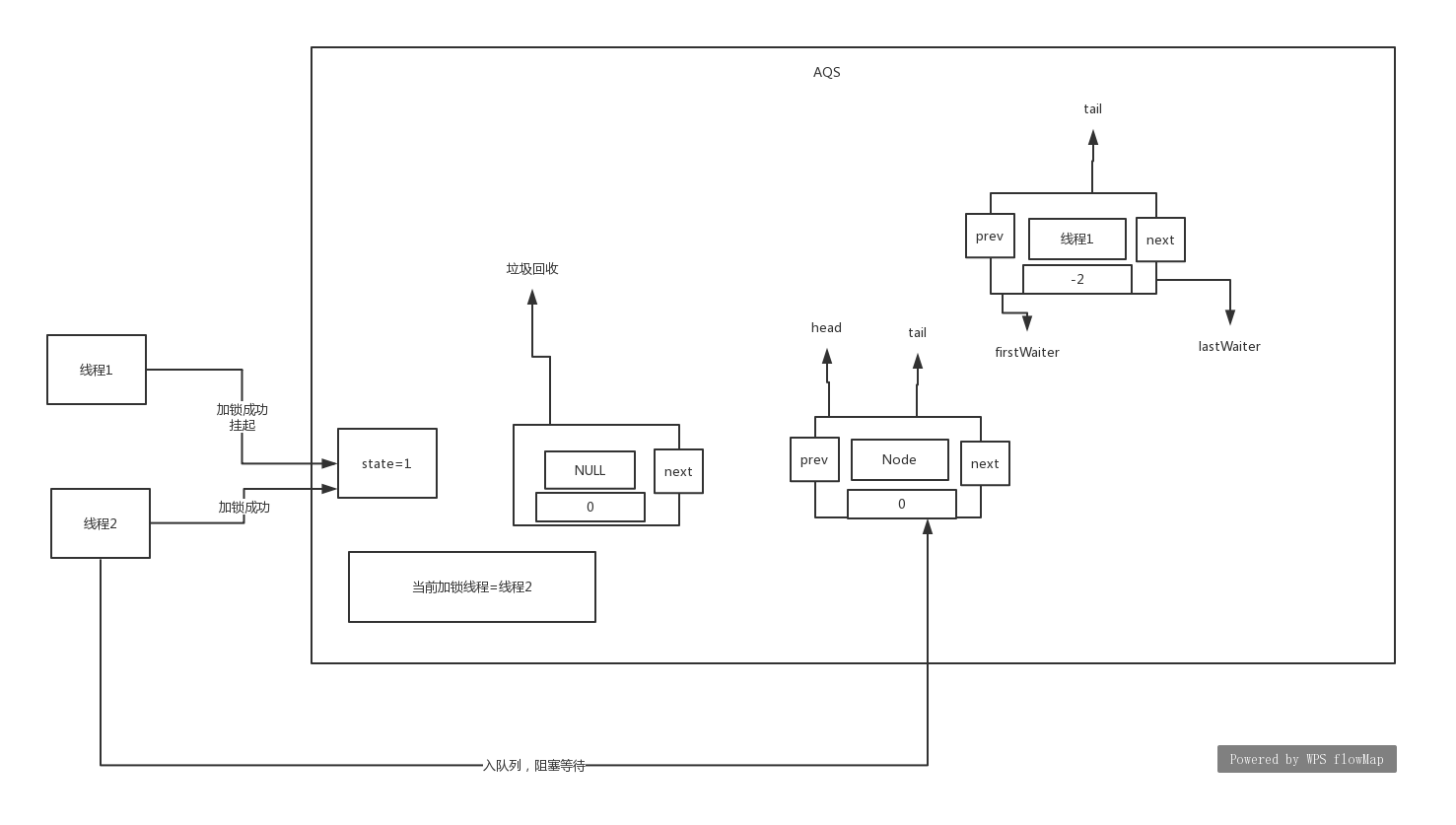
当线程2执行完signal()操作会怎样呢?
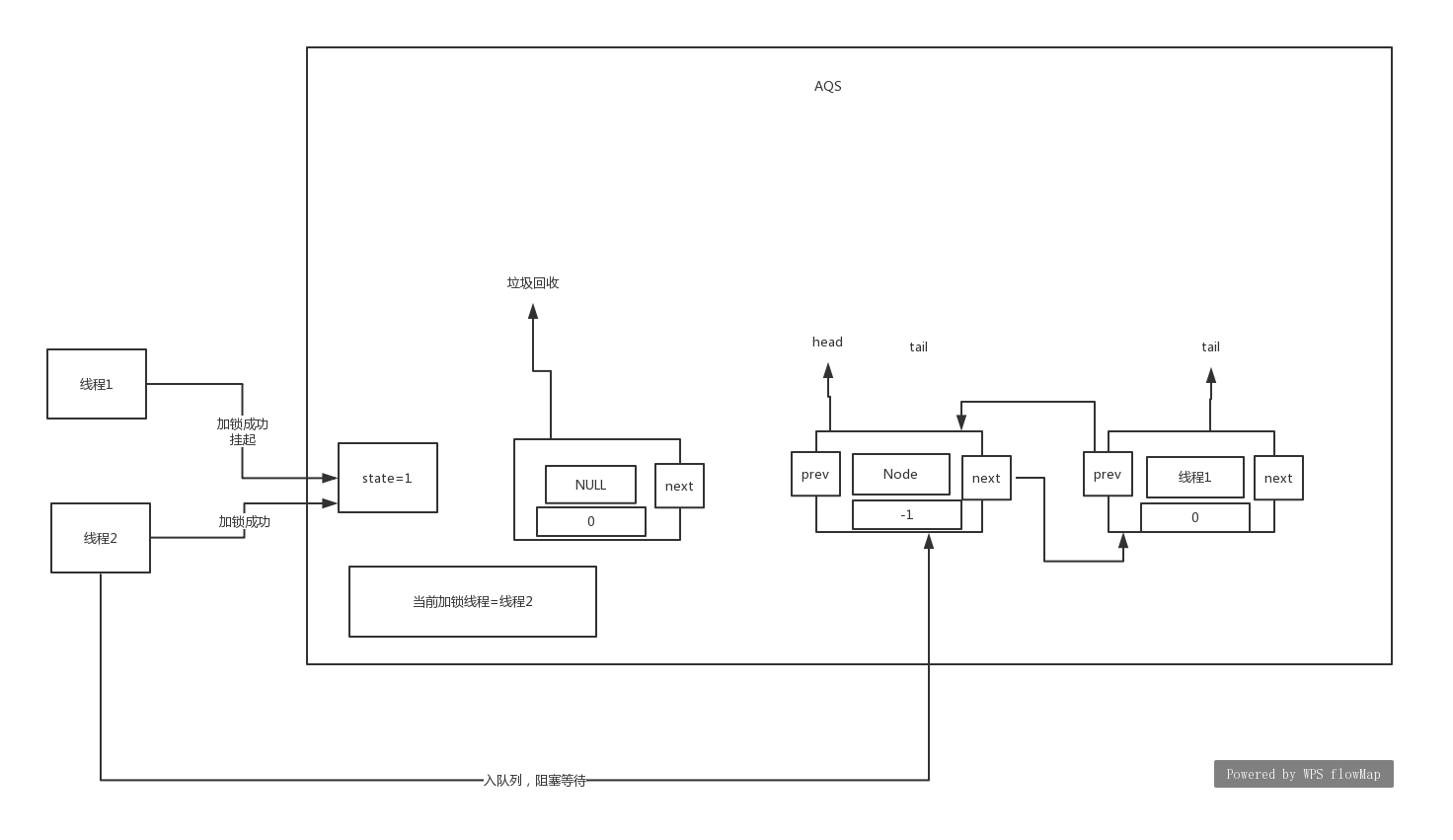
其实可以发现,当线程2执行完signal()方法,其实是将线程1从condition队列放到了阻塞等待队列。这样线程1又可以等待唤醒,来继续获取锁了。这两个图就能完全说明await()和signal()方法的功能了。总结下:线程1执行await()方法其实是将自己放入到一个condition队列,并将自己挂起。然后线程2执行signal()方法,会从condition队列转到阻塞等待队列。然后线程2释放锁,就会唤醒线程1来执行了。





















 1077
1077











 被折叠的 条评论
为什么被折叠?
被折叠的 条评论
为什么被折叠?








